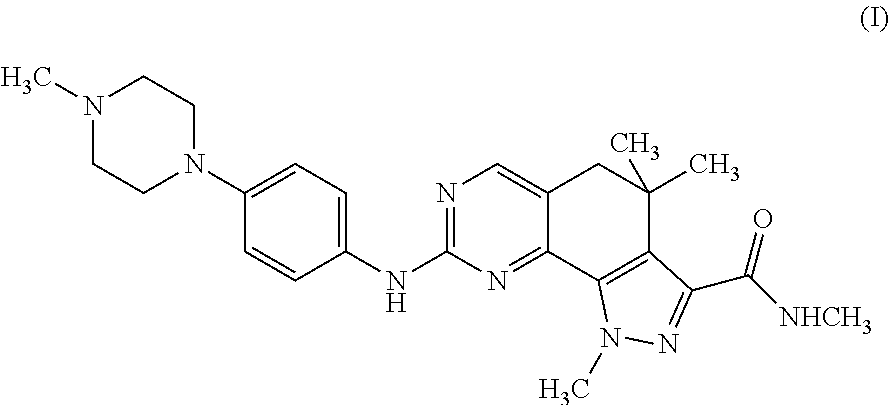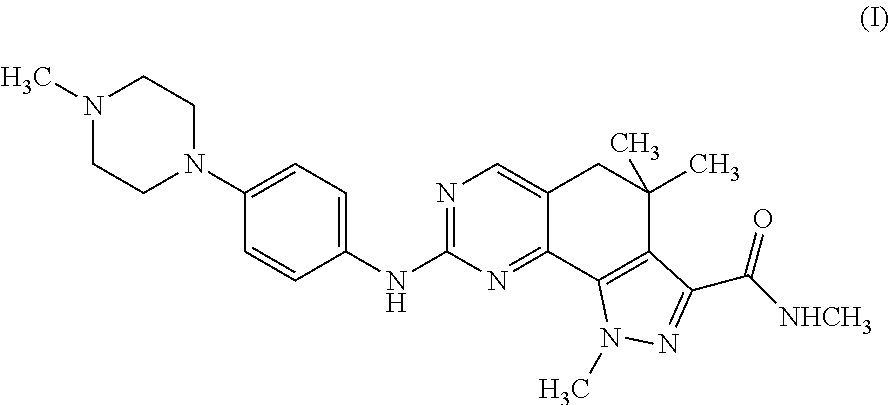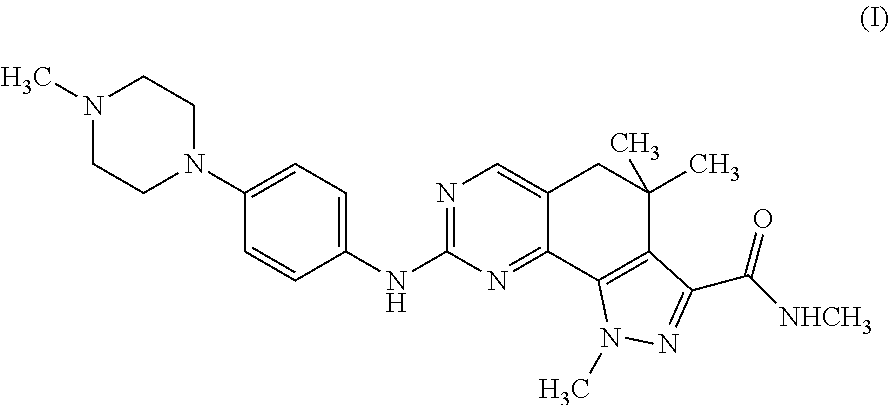Use of kinase inhibitor for the treatment of thymoma
a kinase inhibitor and thymoma technology, applied in the field of thymoma and thymic carcinoma patients, can solve the problems of local invasion, pleural dissemination, distant metastases, etc., and achieve the effect of inhibiting the proliferation of thymoma
- Summary
- Abstract
- Description
- Claims
- Application Information
AI Technical Summary
Benefits of technology
Problems solved by technology
Method used
Image
Examples
example 1
Scintillation Proximity Assay (SPA) Format for Kinases
[0032]This assay allows measurement of the inhibition of the kinase activity of a specific enzyme obtained with test compound. Different kinases can be tested in parallel.
[0033]A biotinylated substrate is trans-phosphorylated by a specific kinase in the presence of ATP including a γ33-ATP tracer. At the end of the reaction the phosphorylated substrate is then captured using Streptavidin-coated SPA beads. A dense 5M CsCl solution is added and the mixture is incubated for four hours. This causes the SPA beads to float to the top of the CsCl solution containing the unincorporated radiolabelled ATP.
[0034]The extent of phosphorylation is measured using a 13-counter. In these assays, the compound of formula (I) showed a potent inhibitory activity on the CDK2 / Cyclin A complex (IC50=45 nM), showing activity also towards closely related CDKs, i.e. CDK1, CDK4, and CDK5 (IC50=398, 160 and 265 nM, respectively), but also towards Tropomyosin ...
example 2
Objective Tumor Response achieved in a Thymic Carcinoma Patient
[0035]An objective tumor response was obtained in a 24 years old female patient, first diagnosed with thymic carcinoma in May 2002 and having had her third progression of disease with metastases to lung in July 2007, entered the phase I clinical trial in September 2007. Treatment with the compound of formula (I) was administered at the daily dose of 150 mg with schedule of treatment encompassing four days of treatment followed by three days of rest for three weeks in a four-week cycle. After 10 cycles of treatment, the patient showed a partial tumor response (PR) as per RECIST criteria in solid tumors (Therasse P, Arbuck S, Eisenhauer E A, Wanders J, Kaplan R S, Rubinstein L, et al. New guidelines to evaluate the response to treatment in solid tumors. J. Natl. Cancer Inst., 2000; 92 (3): 205-216), with a 31.2% decrease in the sum of target lesions compared to baseline; the PR was confirmed one month later and was documen...
example 3
Objective Tumor Response Achieved in a Second Thymic Carcinoma Patient
[0036]Another objective tumor response was obtained in a 62 years old male patient, first diagnosed with thymic carcinoma in May 2006, becoming metastatic to lung, bones and peritoneum in October 2007. The patient started treatment in the phase I clinical trial in December 2008. Treatment with the compound of formula (I) was administered at the daily dose of 150 mg with schedule of treatment encompassing four days of treatment followed by three days of rest for three weeks in a four-week cycle. After 6 cycles of treatment, the patient showed a partial tumor response (PR) as per RECIST criteria with a 30% decrease in the sum of target lesions compared to baseline and stable non-target lesions; the PR was confirmed one month later, with a 40% decrease in the sum of target lesions compared to baseline and stable non-target lesions. The patient, prior to be treated in the clinical trial, received one line of chemother...
PUM
| Property | Measurement | Unit |
|---|---|---|
| pharmaceutical composition | aaaaa | aaaaa |
| molecular weight | aaaaa | aaaaa |
| size | aaaaa | aaaaa |
Abstract
Description
Claims
Application Information
 Login to View More
Login to View More - R&D
- Intellectual Property
- Life Sciences
- Materials
- Tech Scout
- Unparalleled Data Quality
- Higher Quality Content
- 60% Fewer Hallucinations
Browse by: Latest US Patents, China's latest patents, Technical Efficacy Thesaurus, Application Domain, Technology Topic, Popular Technical Reports.
© 2025 PatSnap. All rights reserved.Legal|Privacy policy|Modern Slavery Act Transparency Statement|Sitemap|About US| Contact US: help@patsnap.com



